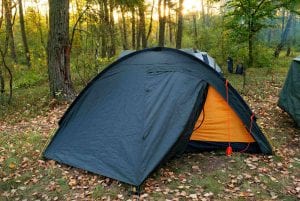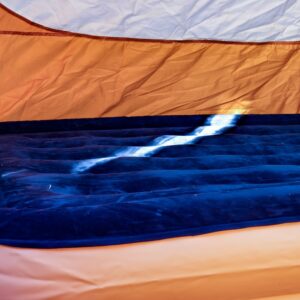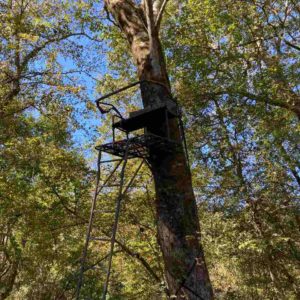Water-repellent down has been a game-changer for sleeping bags. These days you can effectively have the best of both worlds — the superior insulation and compressibility of down, paired with the water repellency of a synthetic bag.
But is it possible to waterproof your own down bag using easily available products? And more to the point, do you need to?
- Loads of manufacturers make water-resistant down sleeping bags. Sometimes it’s the shell fabric that repels water, while in other cases the down fill is treated with a water-repellent agent.
- You can also use wash-in or spray-on treatments to give your down sleeping bag a degree of water-resistance.
- While waterproof down can be great, an untreated down bag is often fine too. The most important thing is to keep it dry on the trail and in the tent.
Buying Water-Resistant Sleeping Bags
The best way to achieve a water-resistant down sleeping bag is to buy one that’s made that way.
If you’re not sure where to begin, check out our guide to this year’s best down sleeping bags.
Outdoor gear manufacturers have invested huge amounts of time and money in sleeping bag materials. In some cases, they’ve focused on water-repellent membranes and shell fabrics, while in other cases they’ve devised treatments that improve the wet-weather performance of the down fill itself.
The Rise of Treated Down
Treated down insulation has lots of different proprietary names depending on who’s made it. For example, you might see it called “Hydrophobic Down,” “Dridown,” or “Ultra-Dry Down.” These technologies work by coating the down filaments in a water-repellent substance — usually wax, silicon, or perfluorinated compounds (PFCs).
Performance varies, but it can be comparable to synthetic bags. Generally it has three main advantages over untreated down:
- It absorbs less moisture if it gets wet.
- It insulates more effectively when damp.
- It dries more quickly.
Water-Resistant Shell Fabrics
Rather than — or sometimes as well as — treating the down itself, some manufacturers concentrate on the shell material of the sleeping bag. They may use a durable water repellent (DWR) coated fabric, or even a water-resistant breathable membrane.
Some gear designers might also mix up their materials, opting for a heavier and more waterproof shell fabric in areas that are more likely to get wet — like the foot-box or hood.
How Waterproof Can Sleeping Bags Really Be?
Despite this eye-catching demonstration of someone in a high fill power Nikwax Hydrophobic Down bag floating in a glacial lagoon, you won’t find a completely waterproof sleeping bag. And if you could, you wouldn’t want it.
Think about it — why don’t gear manufacturers just make the sleeping bag shell out of heavy-duty plastic trash sacks? The moisture wouldn’t get in from outside, but you’d still get wet because you’d pickle in your own body vapor and condensation.
Moisture control is about finding a balance between waterproofing and breathability. Water-repellent down and hydrophobic shell fabrics represent a great compromise, but you’ll still want to keep them as dry as you can when you’re out on the trail.
Waterproofing Sleeping Bags at Home
Whether or not your down bag already has some level of waterproofing, you can also buy home treatments to improve moisture-resistance or restore water repellency. Generally, these come in either wash-in or spray-on form.
Wash-in Treatments
You should always follow the instructions of the particular brand you’ve chosen, but in general these will work better on a clean sleeping bag. So before you proof the bag, launder it with a dedicated down wash to remove grease and dirt. This should also improve the insulating qualities of the bag too.
Wash-in down treatments will normally lend some degree of waterproofing to both the down fill and the shell fabric, but be aware that you’ll need to make sure the bag is absolutely dry afterwards. The best way to achieve this is by using a commercial tumble dryer on a medium heat. Drop in a couple of clean tennis balls to help the down loft up properly, and take a good book — you could be there a while.
Spray-on Treatments
Spray-on waterproofing treatments are for the shell fabric rather than the down fill, but they will also work better on clean down bags. Usually they work by “topping up” an existing water-repellent coating, causing water droplets and condensation to bead on the surface rather than soaking through into the down fill.
Instructions will vary for different brands, but aim to get a consistent coating — and focus on vulnerable areas like the foot box and hood. Remember that some spray-on treatments may contain harmful chemicals, so you’ll probably want to proof your sleeping bag outside or in a well-ventilated area.
Protecting the Sleeping Bag in Your Backpack
Plenty of seasoned outdoor adventurers would argue that fancy polymer treatments and waterproof shell fabrics aren’t really necessary — and in fact some manufacturers actively avoid treated down. The real key to waterproofing your sleeping bag is protecting it from moisture when you’re on the trail.
It’s likely to be at its most vulnerable when it’s on your back. We’ve all been caught outdoors in biblical rainstorms, and on those wash-out days it’s even more important to be able to slide into a warm sleeping bag when you’re done.
Lining the Stuff Sack
Some folk swear by a tough trash bag inside the stuff sack for your sleeping bag. It’s a last line of defense and in truth you probably don’t need it if you’re also using dry-bags, liners and waterproof pack covers — but then, for the miniscule amount of extra weight, what do you have to lose?
Dry Bags
As far as we’re concerned, there are two key rules with dry bags:
- Always use them.
- Never trust them.
Don’t get us wrong, dry-bags are great, but they’re often not as watertight as they claim to be — especially if they’re the budget ones that you can pick up on a 5 for $15 deal. Even good ones are likely to deteriorate over time, and outdoor life is rough on gear. You only need to snag it on a crampon or pack it next to the spout of a kettle to create that fatal little rip and end up with a wet sleeping bag.
Rucksack Covers and Liners
For this reason, we’d suggest the principle of doubling up. Yes, you should absolutely keep your sleeping bag in a dry-bag, but you should also use a rucksack liner or an external cover.
Which one you pick is up to you. A cover is easy to get on and off — and also allows the contents of your backpack to air a bit when the sun’s out — but they can be a liability in high winds. They also don’t always provide the best coverage from directional rain, and you’ll tend to find a bit of moisture creeping into your pack.
Rucksack liners are normally more watertight, but they make it a lot harder to get to your gear. Modern packs often come with multiple entry points that allow you to access gear that’s lower down your pack, but if the whole lot is packed in a liner then you can end up tipping the entire bag out just to get to something that you’ve inadvertently buried near the bottom.
Placement
There’s a timeworn snippet of trail wisdom that you should always keep your sleeping bag right at the bottom of your pack. We’d like to suggest — based on extensive personal experience — that this isn’t very wise at all.
The thing is, water tends to pool in the bottom of your rucksack, especially if you’re using a cover. So whatever you put there may well end up marinating all day in rainwater. It only takes one leaky seam in your dry-bag, and that lovely down insulation will start wicking up moisture like toilet paper.
Instead, it’s best to keep your sleeping bag near the bottom of your pack, reserving the very lowest spot for something like your air mattress that can get damp without any ill effects.
Protecting the Bag in Your Tent
While the backpack is the biggest danger zone, your down bag can also get wet while it’s laid out in your tent.
Obviously, a lot of this is just common sense. If you throw soaked gear on your bag, climb inside wearing wet clothing, or let a sopping wet dog frolic all over it, then your down sleeping bag will not thank you for it. But it’s also worth considering how you might protect your bag during damper camps.
Mats and Groundsheets
You can save weight by using a tent without a groundsheet, but this does make your sleeping bag more vulnerable to moisture from the ground. Have a look at the expected conditions before you set out, and consider whether the possibility of getting wet is worth shaving a few grams off your pack.
Whether or not you use a groundsheet, a decent sleep mat should almost always be part of your equipment. It provides comfort and insulation, but also protects the bag from moisture.
Bivy Bags
In really wet conditions — or when you can’t absolutely rely on your tent to keep the rain out — some hikers recommend using a lightweight synthetic bivy sack over the top of the sleeping bag. It can also be a good idea if you’re sleeping directly on snow — for example in a snow cave or hot-tent.
This will keep moisture out, but as you’ll know if you’ve ever slept out in a bivy sack, it can also keep moisture in. Even a good bivy bag will compromise the breathability of your sleeping bag, so it’s best not to go down this route unless you really need to.
Liners
There’s a school of thought that a sleeping bag liner will stop sweat and condensation making your down sleeping bag damp.
Honestly, we’re not so sure. A decent down sleeping bag is designed to be breathable, and if you’re using it in conditions that are appropriate to the fill power of the bag, you really shouldn’t have problems with condensation.
That doesn’t mean liners aren’t often a good idea for other reasons. They can “upgrade” your bag by providing an extra layer of insulation, and they can also protect the down fill from dirt and sweat — meaning you need to wash it less often.
Foot Box Protectors
If your sleeping bag gets wet, nine times out of ten it will be in the foot box area where it touches the end of the tent. Some campers like to protect against this by sticking the foot of the sleeping bag in a plastic sack, a dry-bag, or a rucksack — or just covering it with their rain jacket.
Ventilation and Airing
Good campcraft and gear maintenance can go a long way towards making sure you have a dry sleeping bag.
- Avoid condensation by keeping your tent well-ventilated.
- Air your sleeping bag out — preferably in the sun — before you pack it away.
- Wash your sleeping bag when it starts to get dirty.
- Don’t store your sleeping bag compressed between trips.
FAQs
How Do I Protect My Down Sleeping Bag?
Pack your down sleeping bag in a dry-bag, and use a rucksack liner or cover. You might also want to use a water-repellent down treatment.
Is a Down Sleeping Bag Ruined if It Gets Wet?
Not at all, but untreated down won’t insulate very well when wet, and you should get it completely dry as soon as possible.
Should You Waterproof a Sleeping Bag?
You can, but you don’t always need to. Waterproofing can affect breathability, and usually you’ll be fine if you just keep your sleeping bag dry when you’re on the trail..
How Do You Waterproof Down?
Some down sleeping bags come pre-treated for water-repellency, but you can also use wash-in or spray-on down treatments.





